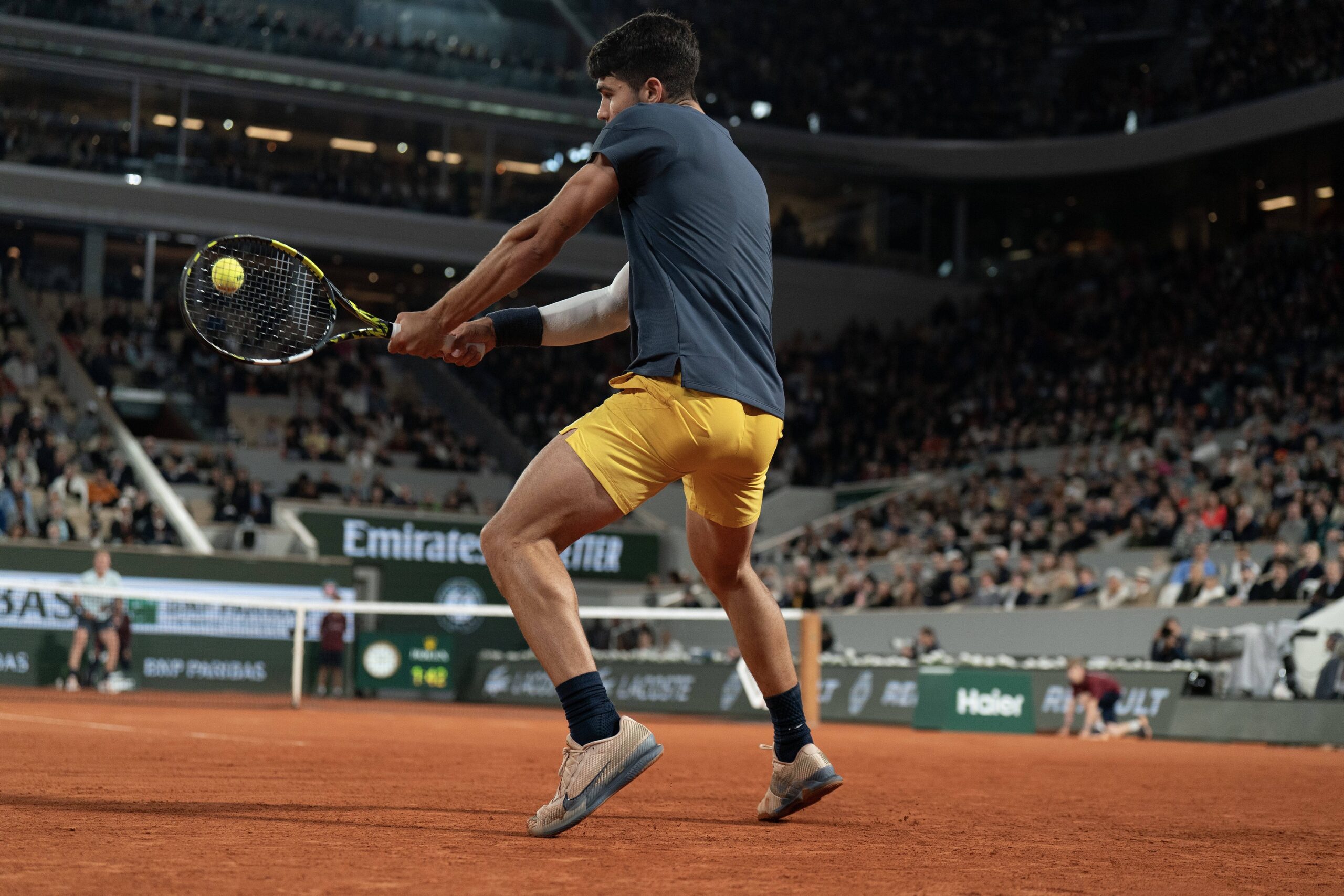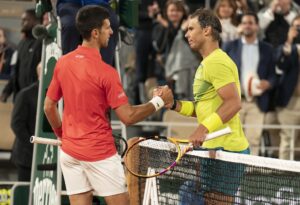In the aftermath of Carlos Alcaraz winning his first French Open, there has been much discussion about what to call his achievement in becoming the first man in the Open era to win his first three Majors on the sport’s three different surfaces: hardcourt, grass and clay.
“The Surface Slam” has been suggested, but perhaps tennis can borrow a term from rugby union and call it “The Triple Crown,” the phrase used in the Six Nations tournament to describe any one of England, Scotland, Wales, or Ireland beating all the other British and Irish teams. It is fitting because the Triple Crown is usually regarded as the precursor to the Grand Slam itself (one team beating all the other five nations in the tournament), and Alcaraz seems set to achieve the Grand Slam in tennis by winning the Australian Open before too long.
Triple Crown Is A Testament To Alcaraz’s All-Round Ability
The Triple Crown is also a fitting description of Alcaraz’s achievement because it is a testament to the all-around nature of his game, such that he looks almost equally at ease on clay, grass, or hardcourt. Indeed, the Spanish prodigy has already been described as potentially the most complete tennis player the world has ever seen—one without any significant weaknesses in his game.
In part, that is surely the legacy of his emerging at the end of The Big Three era and somehow embodying the best of each individual member of The Big Three: volleying like Federer, baselining like Nadal, and defending like Djokovic. Having been born just before the start of The Big Three era (he was born on 5 May 2003, or about two months before Roger Federer won his first Wimbledon title), Alcaraz has literally grown up in the shadow of the mighty triumvirate who have dominated men’s tennis for the last 20 years, all of whom eventually completed the career Grand Slam of winning each one of the four Major Singles titles at least once. Consequently, consciously or otherwise, he has emerged as the perfect post-Big Three player by becoming as complete an all-court and all-surface player as they did. And he has done so much faster than they did.
The Big Three only completed their own Triple Crowns of Tennis (winning a Major on each of the three surfaces the sport is played on) much later in their career than Alcaraz has done. Rafael Nadal did so when he won the Australian Open in 2009, aged 22; Roger Federer when he won the French Open in 2009, aged 27; and Novak Djokovic when he won at Roland Garros in 2016, aged 29. By contrast, Alcaraz is still only 21.
He Has Achieved The Triple Crown of Tennis Faster Than The Big Three
It is fitting that A]lcaraz has achieved the Triple Crown of Tennis much earlier than even The Big Three because speed is arguably the single most defining characteristic of both his play and his personality. He is remarkably rapid around the court, can inject acceleration into a rally by suddenly producing a more powerful shot than his opponent, arguably better than anyone else ever has done, and can also simply floor it in a match to accelerate away from an opponent by winning a succession of games at high speed, even when he is behind in a match. Ultimately, that was what he did against Sacha Zverev in the French Open Final, when he responded to going two sets to one down (after virtually throwing away a third set that he had led throughout) by winning the fourth and fifth sets in an incredibly aggressive fashion.
In addition, Alcaraz is obviously a fast learner, or perhaps a hypersonically fast learner would be more accurate. Just as he has learned from the collective genius of The Big Three throughout his entire life and career, so he has shown an astonishing ability to learn even from his own mistakes. A year ago, he was so tense – indeed, so hyped-up – against Novak Djokovic in the French Open semifinal that he ended up suffering full body cramps and losing the match limply.
A year on from that, he showed against both Zverev in the final and Jannik Sinner in the semifinal that he had learned how to cope with any signs or symptoms of physical distress. Against both Zverev and Sinner, he not only went two sets to one down but also seemed to be suffering from cramps and other physical problems. But unlike against Djokovic in 2023, he kept his composure, played himself back into the match, and then accelerated away from his opponent at the end.
Alcaraz Has Added Mental Strength To All His Physical Attributes
In beating both Zverev and Sinner in succession and in such a similar fashion, Alcaraz also proved beyond doubt that he has added astonishing mental strength to all his physical attributes. Of course, he has hardly been lacking in mental fortitude, as he proved emphatically in besting Novak Djokovic over five sets at Wimbledon last summer. Nevertheless, there is no denying that his third Major victory so far was qualitatively different from his previous two.
When he won both the US Open in 2022 and Wimbledon in 2023, Alcaraz was playing either at or close to his spectacular best. By contrast, he had entered the 2024 French Open in anything but his best form or fitness. Like almost all the top men, with the exception of Zverev, he had been struggling with injury before Roland Garros, and it was not even certain that he would enter the tournament, let alone win it.
Over the course of the next two weeks, however, Alcaraz proved that he could win Majors without being at his best. Essentially, he played himself into form and fitness during the first five rounds of the French Open, and then he was ready to fight it out with both his opponents and even his own lapses of form in the semifinal and final. Perhaps because he had gone into the tournament relatively underprepared and lacking in match fitness, both the semifinal against Sinner and the final against Zverev had more ups and downs than the average rollercoaster, but he still rode out those waves of fluctuating form to triumph.
That is obviously very daunting for all the other men in tennis. Alcaraz had already proven to everyone that he could win Majors while playing well, but now he has proven that he can win Majors while playing sub-optimally. In effect, he can either glide to victory or grind his way to victory, but either way, he is capable of winning, even against the very best opponents.
French Open Win Confirms Alcaraz’s Absolute Singularity
Above all, Alcaraz’s first French Open win has confirmed his absolute singularity in men’s tennis at the moment. For all the talk about Grand Slams and Triple Crowns, there is now surely no doubt that he stands alone and apart from even the best of his contemporaries.
Jannik Sinner has rightly become World No.1, the first Italian man or woman to do so since the rankings were introduced in the early 1970s, after his own amazing run over the last nine months, which has encompassed both his first Major win in Melbourne earlier this year and leading his country, Italy, to Davis Cup triumph last autumn. Nevertheless, Alcaraz now has three Major Singles titles to Sinner’s one, and within a month, he may have four if he can successfully defend his Wimbledon title. And none of Alcaraz’s other contemporaries have even one Major Singles title to their name.
Sinner has proven that he is more than capable of challenging Alcaraz at the top of the men’s game, but he still has to prove himself on either grass or clay by winning a Major title on those surfaces. Alcaraz already has, so it will surely be significantly easier to win more of them on all three surfaces in the future.
Consequently, achieving the Triple Crown of Tennis may well prove to be just a staging post on the way to greater glory. If Alcaraz wins the Australian Open, he will achieve the Career Slam of winning all four Majors. If he does so in any of the three editions of the tournament up to and including 2027, he will become the youngest man to win the Career Slam in the Open era, beating Nadal’s record, set when he won the US Open in 2010, aged 24..
Even more tantalizingly, Alcaraz may ultimately prove himself capable of winning the one thing that even The Big Three could not achieve, namely a Calendar Slam, or, more accurately, the actual Grand Slam of winning all four Major titles in one year. If he ever achieves that truly historic milestone, becoming only the third man in tennis history to do so (and the first in more than half a century), then in at least one respect, he will have eclipsed even the colossal achievements of The Big Three.
Main Photo Credit: Susan Mullane – USA TODAY Sports






